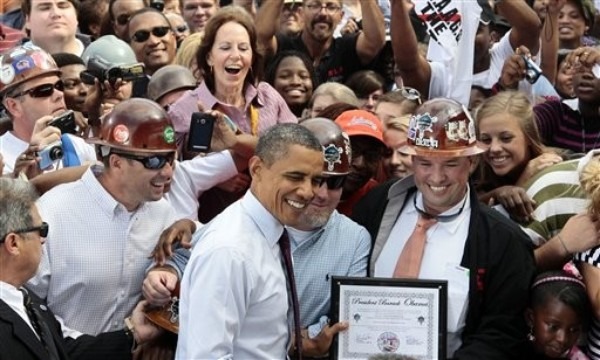Since the late 90s, political pundits have debated how to define the working class and how to explain their voting patterns. Prior to the 2000 presidential election, a standard definition of the working class combined income, occupation, and education. Ruy Teixeira and Joel Rogers made the case for using education in part because exit polls didn’t ask for occupation. They noted that 45 percent of voters were white and working-class, and, when all working-class voters were included regardless of race, the working class was an absolute majority.
Political scientist Larry Bartels agreed, though he used an income-based definition and subdivided the working class to show that the bottom third of the white working class by income was strongly Democrat. On the other hand, Thomas Frank argued that the white working class was becoming more conservative and moving away from the Democratic Party, voting their moral interests rather than their economic position.
In response to George W. Bush’s victory in 2000, The Nation asked, “Who Lost the Working Class?” A few years later, Bill O’Reilly claimed that 60 percent of the country was now working class, based on occupational indicators defined by Michael Zwieg, and he promised that he and other conservatives were “looking out” for them. More recently, Charles Murray argued that the white working class supported Democratic polices involving government and the social safety net because they had lost the “founding virtues” of family and hard work. On the other hand, Salon’s Joan Walsh explained that the white working class had lost confidence in government and that liberal Democrats had alienated the white working class.
The shifting definitions and perceptions of the working class and its politics often obscured a fundamental issue: racial polarization. As Ron Brownstein has observed about recent presidential elections, Obama needed 80 percent of all minorities and 40 percent of whites to win election. While the working class as a whole gave Obama majorities in both 2008 and 2012, within the working class, whites voted nearly 2 to 1 against Obama. Because of these patterns, discussions of working-class voting have focused on white working-class voters.
There is no one working class, and definitions of the working class that use education, income, or occupation alone have limited value.
In his new book, The White Working Class Today: Who They Are, How They Think, and How Progressives Can Regain Their Support, Andrew Levison tries to move the discussion forward. He points out that most definitions of the working class focus narrowly on educational attainment or on some configuration of income and/or occupation. Using data from the Bureau of Labor Statistics and surveys of attitudes, Levison finds that the working class is quite large and urban, and a significant majority is white.
But he also reminds us that there is no one working class, and definitions of the working class that use education, income, or occupation alone have limited value. He argues that political scientists and pundits may do better to consider the political diversity of the working class. They should pay attention to “how ordinary workers think—how they process, store, and organize political ideas and opinions.”
Looking at political values, Levison finds a diverse range of views among the white working class, ranging from conservative to liberal/progressive to “open-minded.” This echoes the way political operatives think about potential voters: those who are against us, those who are with us, and those who could be persuaded. Most important, Levison suggests that we should see much of the working class as pragmatic—that is, as voters who could be persuaded to support either side—rather than as ideologically committed to specific economic or moral values. For those pragmatic voters, what matters is policy, not party.
Contrary to conventional wisdom, Levison does not believe that shifts in geography have changed the political orientation of the working class. Rather, he thinks that the working class should be studied in more individualistic terms in light of shifting values. He concludes that working-class value systems are largely shaped by four institutions—church, education, the military, and small business. Yet this “cultural traditionalism,” as Levison calls it, translates into both conservative and progressive political views. Both draw upon the same framework, but importantly, different life experiences lead working-class people to different political positions.
Levison also shows that the majority of white working people are not strongly conservative, as some might believe. In polls, less than 50 percent expressed “strong agreement” with conservative propositions, and on some questions conservative support was as low as 20 percent. This suggests that a significant proportion of white working-class voters are sufficiently open-minded that they could be persuaded to support progressive politics and candidates.
Here Levison becomes more partisan and suggests that the Democratic Party should appeal to the large “open-minded” working class through economic and social policies. First, it must eliminate the party’s elitism and condescension toward the working class. But the Democrats must also replace approaches based on identity politics with a more pragmatic populist rhetoric focused on policies that the working class participates in formulating. That means rebuilding working-class community and labor organizations and giving the working class more opportunities to participate in policy formulation. None of this will be easy, but it is necessary to counteract the Republicans’ money, pointed critiques of liberalism, counter-narratives, and their own grassroots institutions.
The White Working Class Today is an important book that should be read by journalists, political scientists, and political operatives. But I have several concerns. First, I would have liked to see something about how the white working class differs from the white middle class and from people of color of all classes. That more complex analysis might help Democrats solve a core puzzle: how to appeal to the white working class while also mobilizing the young people, educated white women, LGBT voters, and people of color who helped Obama win reelection? This will be particularly important in the upcoming midterm state elections in 2014.
Second, Levison also puts too much emphasis on messaging while largely ignoring specific policies. He recommends ways to talk to working-class voters but offers few suggestions about what to do about the problems they face. Democrats have rightly been criticized for the gap between their populist campaign rhetoric and their often-neoliberal policies. While Republicans are responsible for most recent legislative inaction, Democrats too often get blamed. That frustrates working-class voters and makes them susceptible to Republican appeals to “libertarian populism.” At some point, the Democrats must address the policy gap.
Finally, Levison assumes that Democratic politicians and apparatchiks are committed to improving the life chances of working-class people. I’m not sure that’s true. In fact, most politicians conspicuously avoid even using the term working class. Rather, their messages subsume the working class under aspirational terms—”middle class” or “working people.” Most Democratic politicians understand that while they need working-class support, they cannot alienate their more elite donors. And too often, that shapes their political behavior.
John Russo is a Visiting Research Fellow at the Metropolitan Institute of Virginia Tech University and the associate editor of Working-Class Perspectives, where this originally appeared.






0 Comments